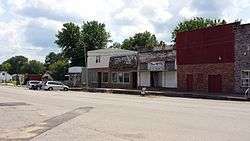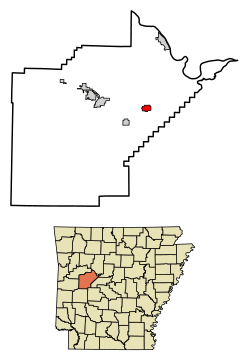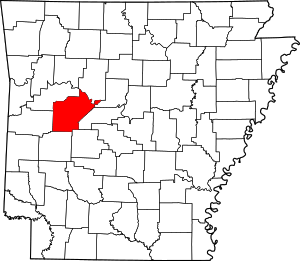Ola, Arkansas
Ola is a city in Yell County, Arkansas, United States. The population was 1,281 at the 2010 census. It is part of the Russellville Micropolitan Statistical Area.
Ola, Arkansas | |
|---|---|
 Looking east down Highway 10 in Ola | |
 Location of Ola in Yell County, Arkansas. | |
| Coordinates: 35°1′54″N 93°13′17″W | |
| Country | United States |
| State | Arkansas |
| County | Yell |
| Area | |
| • Total | 1.83 sq mi (4.75 km2) |
| • Land | 1.70 sq mi (4.41 km2) |
| • Water | 0.13 sq mi (0.35 km2) |
| Elevation | 361 ft (110 m) |
| Population (2010) | |
| • Total | 1,281 |
| • Estimate (2019)[2] | 1,209 |
| • Density | 710.76/sq mi (274.39/km2) |
| Time zone | UTC−06:00 (Central (CST)) |
| • Summer (DST) | UTC−05:00 (CDT) |
| ZIP Code | 72853 |
| Area code(s) | 479 |
| FIPS code | 05-51560 |
| GNIS feature ID | 0081884 |
As of 2004 it serves as a commercial center in Yell County.[3]
Geography
Ola is located at 35°1′54″N 93°13′17″W (35.031748, -93.221309).[4]
According to the United States Census Bureau, the city has a total area of 2.0 square miles (5.2 km2), of which 1.9 square miles (4.9 km2) is land and 0.1 square miles (0.26 km2) (6.53%) is water.
Demographics
| Historical population | |||
|---|---|---|---|
| Census | Pop. | %± | |
| 1910 | 516 | — | |
| 1920 | 655 | 26.9% | |
| 1930 | 648 | −1.1% | |
| 1940 | 839 | 29.5% | |
| 1950 | 880 | 4.9% | |
| 1960 | 805 | −8.5% | |
| 1970 | 1,029 | 27.8% | |
| 1980 | 1,121 | 8.9% | |
| 1990 | 1,090 | −2.8% | |
| 2000 | 1,204 | 10.5% | |
| 2010 | 1,281 | 6.4% | |
| Est. 2019 | 1,209 | [2] | −5.6% |
| U.S. Decennial Census[5] | |||
As of the census[6] of 2000, there were 1,204 people, 464 households, and 283 families residing in the city. The population density was 648.4 people per square mile (249.9/km2). There were 556 housing units at an average density of 299.4 per square mile (115.4/km2). The racial makeup of the city was 83.89% White, 0.42% Black or African American, 0.25% Native American, 0.25% Asian, 0.17% Pacific Islander, 12.96% from other races, and 2.08% from two or more races. 16.86% of the population were Hispanic or Latino of any race.
There were 464 households, out of which 33.6% had children under the age of 18 living with them, 41.6% were married couples living together, 14.2% had a female householder with no husband present, and 39.0% were non-families. 34.5% of all households were made up of individuals, and 17.9% had someone living alone who was 65 years of age or older. The average household size was 2.44 and the average family size was 3.18.
In the city, the population was spread out, with 28.3% under the age of 18, 8.3% from 18 to 24, 26.5% from 25 to 44, 18.9% from 45 to 64, and 18.0% who were 65 years of age or older. The median age was 36 years. For every 100 females, there were 88.1 males. For every 100 females age 18 and over, there were 84.0 males.
The median income for a household in the city was $19,375, and the median income for a family was $24,125. Males had a median income of $21,250 versus $16,100 for females. The per capita income for the city was $10,117. About 20.1% of families and 27.2% of the population were below the poverty line, including 36.9% of those under age 18 and 29.9% of those age 65 or over.
Education
Public education is administered by the Two Rivers School District, which supports :
- Two Rivers High School—Serves students in grades 7–12.
- Two Rivers Elementary School—Serves students in kindergarten through sixth grade.
It was previously in the Ola School District until July 1, 2004, when it merged into the Two Rivers School District.[7] The merged district formerly operated Ola Elementary School and Ola High School.[8] Ola Elementary School had four buildings; the main building and gymnasium were made of natural rock and opened in 1941. Circa 2001 it had 320 students.[9]
In 2010 Ola High closed as Two Rivers High opened.[10] In 2012 Ola Elementary closed as Two Rivers Elementary opened.[11]
Climate
The climate in this area is characterized by hot, humid summers and generally mild to cool winters. According to the Köppen Climate Classification system, Ola has a humid subtropical climate, classified "Cfa" on climate maps.[12]
Notable person
- Babe Ellison, Major League Baseball player, member of Pacific Coast League Hall of Fame
References
- "2019 U.S. Gazetteer Files". United States Census Bureau. Retrieved June 30, 2020.
- "Population and Housing Unit Estimates". United States Census Bureau. May 24, 2020. Retrieved May 27, 2020.
- Richard, Alan (2004-11-24). "Arranged Marriage: Newly Merged Districts Work to Make Combination Succeed". Education Week. Retrieved 2019-01-05.
Its headquarters is in Ola, the largest town in the district, where people in this part of Yell County travel to do their shopping.
- "US Gazetteer files: 2010, 2000, and 1990". United States Census Bureau. 2011-02-12. Retrieved 2011-04-23.
- "Census of Population and Housing". Census.gov. Retrieved June 4, 2015.
- "U.S. Census website". United States Census Bureau. Retrieved 2008-01-31.
- "ConsolidationAnnex_from_1983.xls." Arkansas Department of Education. Retrieved on October 21, 2017.
- "District Information." Two Rivers School District. January 1, 2011. Retrieved on October 24, 2017.
- "Ola Elementary School." Ola School District. January 24, 2001. Retrieved on May 25, 2018.
- Zilk, Caroline (February 7, 2010). "Two become one: Two Rivers High School still set To open in fall". Arkansas Democrat-Gazette. Retrieved October 16, 2012.
- "State Required Information." Plainview-Rover School District. April 14, 2013. Retrieved on October 24, 2017. See the "ACSIP Plans " section, note the years
- Climate Summary for Ola, Arkansas
